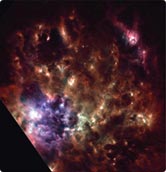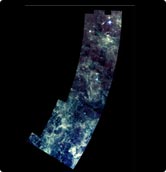In search of the origin of galaxies, stars and planets
When were you most nervous?

Installing AKARI (ASTRO-F) into the nose of the M-V rocket
When the satellite was launched on the JAXA's M-V rocket. Although the M-V rocket is a proven vehicle, this was the first time that it had been used to put a satellite into a Sun-synchronous polar orbit, and when I watched the launch for real at Uchinoura Space Center, my heart was in my mouth.*1 However, I was glad that we were able to use the M-V rocket. As the rocket vibrates heavily at launch, we adopted various countermeasures starting right from the design phase for AKARI. That was possible since the rocket itself was developed at Sagamihara. We were able to go over to consult for fine-tuning of the rocket-satellite interface and resolve problems immediately. When the rocket is on site, it is easier to load a satellite onto a stable solid-fuel rocket.
- *1The M-V rocket
The largest solid fuel rocket in the world. A three stage rocket weighing approximately 1,800 kg with low orbit launch capability. It was first used to launch the radio astronomy satellite HARUCA in 1997. AKARI was launched using M-V rocket No. 8. In September 2006, the rocket was used for the last time ever, for the launch of the solar observation satellite HINODE.
Considering that AKARI is the first dedicated Japanese infrared astronomy satellite, it is working remarkably well. We are putting great effort into the day-to-day work of acquiring data and uploading commands to AKARI. At the same time, perfecting the necessary highly efficient data analysis software is a major task. At the moment, with what has been achieved so far, it feels like peeking through a small hole into a treasure chest of accumulated raw data.
When will the results become available?
It is predicted that AKARI will run out of liquid Helium in mid 2007. At that point, the observation phase at the cryogenic temperature will end and efforts will shift to in-depth data analysis. After a further year, in 2008, the aim is to construct a comprehensive database of the coordinates and brightness of infrared astronomical objects over the entire sky, optimally to resolutions which are an order of magnitude better than the IRAS observations obtained more than 20 years ago. Over a period of a year we will use this database ourselves, optimizing both the products and the analysis. The data will then be published to the world, incrementally, beginning with the brightest astronomical objects. If possible, eventually we would like to publish the data in image form; although in all honesty, prior to the launch of AKARI it was uncertain whether it would be possible to convert the data into images, and so it was never guaranteed that any image data would be published. When we did experiment with the conversion of data into images, the results appeared to be of excellent quality. Thus, we anticipate that we will also be able to publish image maps of the sky.
Far-infrared image of the Large Magellanic Cloud

AKARI/Far-Infrared Surveyor (FIS)
False color composite from images at 65 µm,
90 µm, and 140 µm
Near- and mid-infrared image of the Large Magellanic Cloud

AKARI/ Infrared Camera (IRC)
False color composite from images at 3 µm,
7 µm, and 11 µm
- The latest results of observations by AKARI
Far-infrared and near-and mid-infrared images (above) show the area around the Large Magellanic Cloud
Following the initial data release, we plan to proceed with the data analysis of the fainter infrared astronomical objects and correspondingly revise the database. We too have an avid interest in how galaxies came into being in the ancient Universe, and how they evolved to take on their current form, the types of environment in which stars are formed, and the process by which stars are born. AKARI will also open research into the state of partially formed planetary systems, and the physics of the gas and dust in outer space. AKARI will produce comprehensive databases opening many avenues of research and allow researchers all over the world to make use of the fruits of AKARI's observations. We anticipate this work and research moving full steam ahead.
The development of the AKARI mission required more than an ability in astronomy and optics—it also required fundamental technical capabilities in such areas of expertise as cryogenic temperature material engineering. Although numerous approaches and tenders were made by other companies regarding the development of the telescope, we judged without any doubt that Nikon had the best vision. I believe that, in addition, this project entailed considerable risk for Nikon, since on top of the fact that a completely new material, silicon carbide, was used for the primary mirror construction, in the course of the cryogenic temperature material engineering analysis and experimentation alone, we had Nikon manufacture several hundred different types of materials and structural samples. Working within a limited budget, Nikon pushed itself to the limit. I believe that, thanks to this effort, AKARI has turned out to be a lightweight and compact satellite that will continue to demonstrate its outstanding capabilities over a long period of time.
- The images used were provided by JAXA.
Posted September 2007

